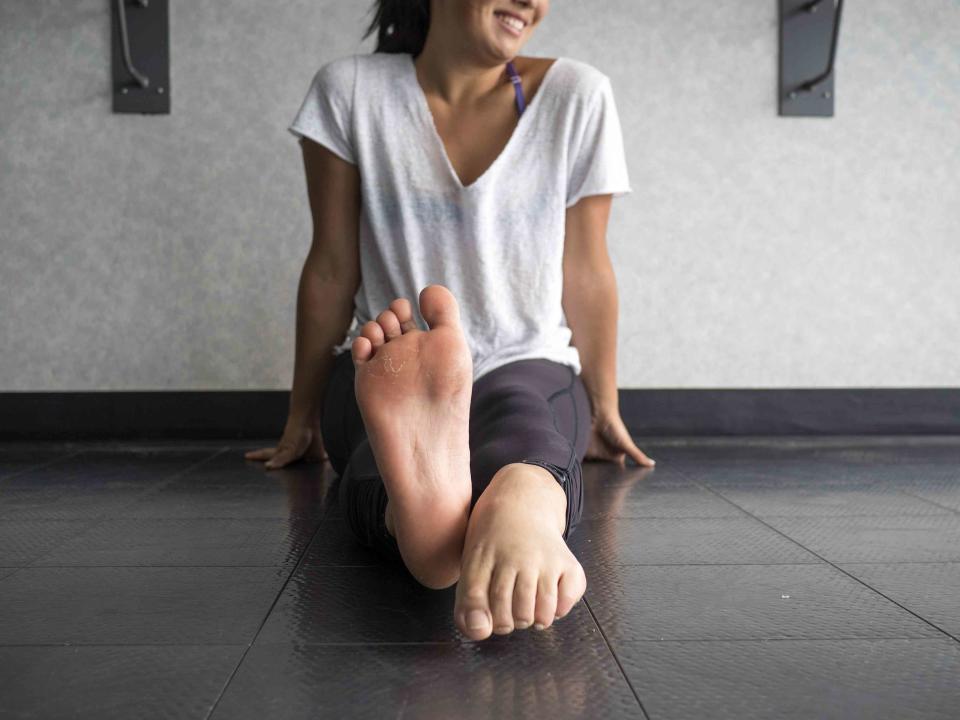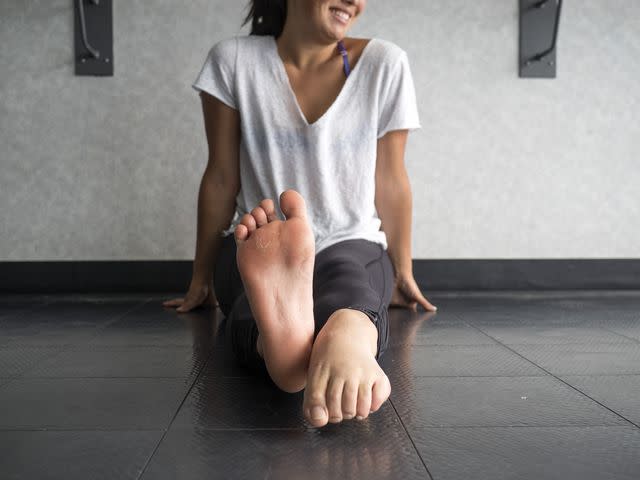7 Exercises to Stretch Plantar Flexion Movement
Plantar flexion—the ankle movement that points your toes—is important for normal movement

kbycphotography / Getty Images
Medically reviewed by Danielle McNeil, D.P.M
Plantar flexion is the movement used when standing on your toes. You’ll do it when you walk, stand tiptoe to reach something high, or push the gas or brake pedals while driving. Performing the plantar flexion movement without pain or trouble is important to everyday tasks.
Muscle weakness caused by stroke, cerebral palsy, and other conditions (especially injuries) can lead to plantar flexion weakness. You can rebuild strength and range of motion over time by practicing stretches and plantar flexion exercises.
Continue reading to learn more about plantar flexion and how to improve this motion through exercises.

kbycphotography / Getty Images
Why Is Plantar Flexion Important?
Plantar flexion is the motion of pointing the toes away from the body. You use it to drive a car, stand tiptoe, and generate momentum when walking.
Weak plantar flexion can impact the muscles in your leg, foot, and back. Having weak plantar flexion can cause:
Changes to your gait (walking pattern)
Tightness in the lumbar soft tissue (muscles and ligaments of the low back), which could lead to back strain
Stiffness in the calf muscles
Having a healthy amount of plantar flexion movement and a full range of motion can help prevent injuries to the feet and legs.
Plantar flexion is the movement of pointing your toes away from your body. Dorsiflexion is the opposite, flexing your foot so that your toes move toward your body. Both are important for engaging the tendons, muscles, and ligaments in the lower leg, ankles, and feet.
Before Plantar Flexion Exercise
Before starting a plantar flexion exercise routine, you should speak with your healthcare provider or physical therapist. This is especially important if you’re recovering from an injury or a recent medical event. Although plantar flexion exercises are low-intensity, it’s best to avoid caution and get medical advice.
Once your healthcare provider has approved a workout, start by warming up with five to 10 minutes of light exercise, like walking or biking. This will help warm up your muscles and encourage blood flow before you start the exercises.
7 Plantar Flexion Exercises
These exercises can be incorporated into your movement routine three to five times a week to help promote plantar flexion and overall health of the lower leg, ankle, and foot.
Always stop stretching if you feel pain.
Downward Ankle Stretch
The downward ankle stretch is about as simple as they come. Do three to five sets of 30–60 seconds on each leg, as follows:
In a seated or standing position, point the toes on one foot. Hold this for 30–60 seconds.
If comfortable, rotate the ankle, making small circles with the toes. Move your toes clockwise, then counterclockwise.
After 30–60 seconds, return that foot to the floor.
Repeat the exercise with the other leg and foot.
Heel Cord Stretch
This stretch engages your calf muscles, which help with plantar flexion. Do two sets of 10 repetitions, as follows:
Stand facing a wall. Place your hands on the wall and your hips facing it.
Step back with one leg.
Keep both heels flat on the floor.
Keep the knee of the front leg bent but the knee of the back leg straight.
Press your hips forward, feeling a stretch through the back leg.
Hold for 30 seconds, then rest for 30 seconds. Repeat this 10 times.
Change legs, and repeat.
For a variation on the heel cord stretch, bend the knee of the back leg. This will give you more of a stretch in the ankle.
Calf Raises
Calf raises simulate standing on your tippy toes, directly engaging the plantar flexion movement. Do two sets of 10, as follows:
Stand near a wall or set a chair out that you can use for balance and support.
Stand straight while facing the wall or chair.
Lift on foot off the floor, bending it behind you.
Keep the other leg straight.
Lift the heel of the straight leg off the floor, raising it as high as possible.
Lower it in a controlled way.
Repeat 10 times.
If this is too difficult, start with calf raises with both feet on the floor. This will give you more stability and help distribute your weight.
Ankle ABCs
This exercise is somewhat silly, but effective. Do one set of the alphabet with each foot, as follows:
Sit down, with your feet not touching the floor.
Point one toe and use it to draw each letter of the alphabet in the air using that foot.
Place that foot down and repeat the alphabet with the other foot.
Toe Pickups
This exercise helps build muscle strength. Do toe pickups as follows:
Distribute 20 or so marbles, cotton balls or other small, lightweight items on the floor in front of a chair. Put a bowl for the items near the chair.
Sit in the chair with both feet flat on the floor.
Using one foot, grab the items with your toes. Deposit them in the bowl.
When all the items are picked up, spread the items out again. Repeat the exercise with your other foot.
Toe Curls
This exercise is similar to toe pickups, but as a slight variation to build strength in the top of the foot. Do it as follows:
Sit in a chair with both feet flat on the floor.
Place a washcloth or towel flat on the floor in front of you.
Using your toes, curl the edge of the towel toward you. Then relax. Repeat this five to 10 times.
Switch legs.
If it's too easy, add a weight to the towel.
Banded Point
This exercise adds a bit of extra resistance to the normal plantar flexion movement. Do three rounds of 10 repetitions. Do it in the following way:
Sit on the floor with your legs extended in front of you.
Loop an exercise band over your toes of both feet, holding the ends in your hands.
Slowly point your feet, pulling against the resistance band. Then, return to neutral.
Plantar Flexion Muscles
Plantar flexion is controlled by muscles in your calves, shin, and foot. Plantar flexion exercises target these muscles, which include:
Summary
Plantar flexion, or the movement of pointing the toes away from the body, is important for everyday activities, from maintaining a healthy gait to standing on tiptoes to driving your car. The muscles in your calf, shin and feet that contribute to plantar flexion can become weak just like any other muscles. These exercises may help you regain or develop a healthy plantar flexion and full range of motion.

